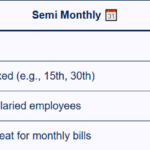If you’ve ever wondered, “what is semi monthly?”, you’re not alone! It’s a term often used for things like salary payments or bills, but it can be a little confusing at first. So, let’s break it down in simple terms and explore how this schedule works, how it compares to other types of payment schedules, and how it can affect your financial planning. 💡
What Does “Semi Monthly” Actually Mean? 🤔
When you hear the phrase “semi monthly,” think about the number two—because it means twice a month. Unlike weekly or bi-weekly payments, semi monthly events happen on fixed dates, twice every month. For example, if you’re on a semi-monthly mortgage payment plan, you’ll pay your lender twice a month, not once every two weeks.
For clarity:
- Semi Monthly = Twice a month
- Example: You might get paid on the 15th and 30th of each month. 📅
Semi Monthly vs Bi-Weekly: What’s the Real Difference? 🤯
Here’s where people often get confused. Semi monthly and bi-weekly sound like the same thing, but they’re not!
Comparison Table:
| Term | Frequency | Paychecks per Year |
|---|---|---|
| Semi Monthly | 2x per month | 24 |
| Bi-Weekly | Every 2 weeks | 26 |
Key Differences:
- Bi-Weekly: You’ll get 26 paychecks per year, and your pay dates move each month.
- Semi Monthly: You get 24 paychecks per year, with fixed dates like the 15th and 30th.
Why Do Employers Choose Semi Monthly Pay? 💼
You might be wondering why some employers opt for semi monthly payments. Here are a few reasons why:
1. Predictability 📅
Employees can easily plan ahead, knowing they’ll be paid on the same two dates every month.
2. Simplicity for Payroll 📊
For the employer, it’s easier to run payroll twice a month than every two weeks, cutting down on administrative costs.
3. Alignment with Bills 💸
For many employees, paying bills on fixed dates is easier to manage. Semi monthly pay aligns well with rent, utilities, and other recurring expenses.
Examples of Semi Monthly Pay Schedules 💰
Let’s take an example to see how semi monthly pay works.
If you earn $60,000 annually, here’s how it breaks down for semi monthly pay:
- $60,000 ÷ 24 pay periods = $2,500 per paycheck.
Pay Schedule:
- January 15 – $2,500
- January 30 – $2,500
- … and so on.
Your paycheck amounts will always be the same and will land on those set dates each month. ✅
Advantages of Semi Monthly Pay 💡
1. Reliable Income 💵
You can easily forecast your income because paydays occur on fixed dates each month, such as the 1st and 15th.
2. Perfect for Budgeting 📈
Semi-monthly payments are ideal for aligning with monthly bills like rent or loans, making it easier to budget your finances.
3. Fewer Payroll Runs 🏢
From an employer’s perspective, processing 24 paychecks annually is more efficient than 26, reducing administrative overhead.
Potential Drawbacks of Semi Monthly Pay ⚠️
Of course, there are a few downsides to the semi monthly payment schedule as well:
1. Payment Timing ⏰
If your pay date falls on a weekend or holiday, you might get paid earlier or later than usual.
2. Irregular Workdays 📅
The number of workdays between paychecks varies. This can be confusing, especially for hourly employees who rely on a set number of hours each pay period.
How to Budget with Semi Monthly Pay 💡
When you’re paid semi monthly, organizing your finances is key to making the most of this schedule. Here are some helpful tips to keep your budget on track:
📝 1. Divide Bills Across Paychecks
- Pay bills like rent or utilities with one paycheck, and use the other paycheck for discretionary spending, like groceries or entertainment.
📝 2. Use a Calendar
- Mark your paydays on a calendar to keep track of your income and due dates.
📝 3. Build an Emergency Fund
- Having a safety net for unexpected expenses can ensure you don’t dip into your regular paychecks.
Semi Monthly for Bills & Loans 🏠
It’s not just paychecks that are affected by a semi monthly schedule—some service providers offer semi monthly payment plans too! Consider paying your mortgage or car loan semi-monthly. Here’s why:
- Interest Savings: Making payments twice a month can help you reduce interest on long-term loans.
- Smaller Payments: With semi-monthly payments, you’re paying smaller amounts more frequently, which can be easier on your cash flow.
Is Semi Monthly Right for You? 🤷♂️
Now that we’ve broken down what is semi monthly, you may be wondering if it’s the right choice for you. Here’s who might benefit from a semi monthly payment schedule:
- Employees who prefer consistency 📅
- People with steady monthly bills 🏠
- Anyone who likes to have a clear pay date twice each month
However, if you have a fluctuating income, or need more flexibility, bi-weekly or weekly payments might be better suited for you.
Conclusion 🏁
So, what is semi monthly? It’s simply a payment schedule that happens twice a month, usually on fixed dates. It can be a great way to keep your finances organized and predictable—whether for your paycheck, rent, or bills. With 24 paychecks per year, semi monthly can provide structure, making it easier to manage your income and expenses.
Frequently Asked Questions (FAQs) 🤔
1. How often is semi monthly?
Semi monthly means you get paid twice a month, typically on dates like the 1st and 15th or 15th and 30th.
2. How many paychecks is semi monthly?
There are 24 paychecks per year when you’re on a semi monthly schedule.
3. Is semi monthly the same as bi-weekly?
No! Bi-weekly pay happens every two weeks, meaning 26 paychecks per year. Semi monthly is twice a month, which results in 24 paychecks.
4. Why do employers use semi monthly pay?
Employers use semi monthly pay for predictability and to reduce the frequency of payroll processing.
5. Can I switch to semi monthly pay?
It depends on your employer’s payroll policy. Some companies may allow employees to request semi monthly pay.



